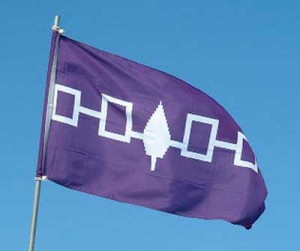Repatriating sacred items is an incredibly important practice. As with repatriating ancestral remains, returning sacred items helps indigenous peoples heal from generations of trauma and cultural suppression. These items are also central to debates about the exhibition of sacred items and about teaching non-Native peoples about Native cultures and lifeways. To illustrate the tensions between the items’ artistic and ethnographic value and their sacredness, I will be discussing Iroquois False Face Society masks.
The Iroqouis, who prefer to be known as the Haudenosaunee, are comprised of six nations: the Cayuga, the Onondaga, the Oneida, the Seneca, the Tuscarora, and the Mohawk. Their ancestral homelands included Northern and Western New York, parts of Ontario and Quebec, and a sphere of influence that extended to Virginia and Illinois (George-Kanentiio, n.d.). The Haudenosaunee have had many sacred items and objects of cultural patrimony taken and withheld from them, including False Face Society masks.

The False Face Society is one of the Haudenosaunee’s medicine societies. The medicine societies cure various ailments with medical rituals. One becomes a member by being cured of an illness as the result of False Face Society rituals or by seeing the beings in a dream. The masks depict supernatural beings and confer healing abilities onto the wearers. To make a mask, one carves human-like, but distorted features into a living tree. Then one must separate the mask from the tree when it’s finished. The masks are regarded as living beings and are given tobacco, oils, and food as offerings. When not in use, the masks are cared for in a manner consistent with their status as vessels for sacred beings (Wallace, 1972, pp. 72-73).
In 1995, the Grand Council of the Haudenosaunee issued a statement forbidding the exhibition and circulation of images of these sacred masks (Chief Leon Shenandoah, 1995). The statement also denounced the sale or distribution of masks to non-Native peoples. However, some Haudenosaunee artists object to this condemnation, stating that their livelihoods depended on art sales and that the masks encourage people to learn about Haudenosaunee cultures. A website for one art supply and variety store discusses the conflicting messages it’s received from Native peoples regarding the sale of False Face Society masks. Unfortunately, some sources point towards non-Native people carving masks like the False Face Society masks for commercial purposes (Chichester, Inc., n.d.).
Chief Jacob Thomas wrote to Chichester saying this:
‘…Particularly today as there are no jobs this may be the only source for the people to make a living is to sell their art…If masks are forbidden to be sold and it becomes too sacred then it will become a secret and no one will be able to carve a mask and know what it means…’ (Chichester, Inc, n.d.).
As of 2017, the Haudenosaunee have repatriated a number of medicinal masks from museums including the National Museum of the American Indian, the Science Museum of Minnesota, the Peabody Museum of Archaeology and Ethnology at Harvard University, and the Cayuga Museum. The Rochester Museum and Science Center attempted to test medicinal masks in its collection for toxic agents and decontaminate them. Unfortunately, museums do not often treat the masks as sacred, and the retention of and desecration of these sacred objects contributes to long term trauma for the Haudenosaunee.

Further Reading
Haudenosaunee Statement on Repatriation
An art supply/variety store discusses the masks
False Face Society information
A Native American Studies blog discusses the False Face Society
Works Cited (Note: Some of these sources contain images of the masks. I did not place any images of the masks in my post because the Haudenosaunee discourage reproducing images of the masks.)
Chichester, Inc. (n.d.). Iroquois False Face Mask Controversy. Retrieved March 2, 2017, from chichesterinc.com: http://www.chichesterinc.com/FalseFaceControversy.htm
Chief Leon Shenandoah, T. (1995). Haudenosaunee Confederacy Announces Policy on False Face Masks. Retrieved March 2, 2-17, from nativetech.org: http://www.nativetech.org/cornhusk/maskpoli.html
Department of the Interior: National Park Service Notice of Intent to Repatriate Cultural Items: Peabody Museum of Archaeology and Ethnology, Harvard University, Cambridge, MA. (n.d.). National Park Service, Department of the Interior. Retrieved from https://www.nps.gov/nagpra/FED_NOTICES/NAGPRADIR/nir0488.html
Department of the Interior Notice to Repatriate Cultural Items in the Possession of the Science Museum of Minnesota, St. Paul, MN. (1996, March 22). The National Park Service, Department of the Interior. Retrieved from https://www.nps.gov/nagpra/fed_notices/nagpradir/nir0026.html
Gale Courey Toensing. (2012, June 16). Return of Sacred Items Heals Onondaga Nation. Indian Country Media Network. Retrieved from https://indiancountrymedianetwork.com/news/return-of-sacred-items-heals-onondaga-nation/
Gale Courey Toensing. (2013, January 4). Cayuga Museum Receives Replica Wampum Belt for Returning Haudenosaunee Spiritual Objects. Indian Country Media Network. Retrieved from https://indiancountrymedianetwork.com/history/events/cayuga-museum-receives-replica-wampum-belt-for-returning-haudenosaunee-spiritual-objects/
George-Kanentiio, D. (n.d.). Ancestral Land Areas of the Six Nations Iroquois. Retrieved March 5, 2017, from manataka.org: http://www.manataka.org/page765.html
The Haudenosaunee Confederacy. (n.d.). Haundenosaunee Statement on Repatriation. Retrieved March 5, 2017, from onondaganation.org: http://www.onondaganation.org/government/policy/haudenosaunee-statement-on-repatriation/
The Haudenosaunee Confederacy. (n.d.). Understanding Haudenosaunee Culture. Retrieved March 4, 2017, from peacecouncil.net: http://www.peacecouncil.net/NOON/articles/culture1.html
Ojibwa (Username). (2010, November 28). The Iroquois False Face Society [Blog]. Retrieved from http://nativeamericannetroots.net/diary/787
Rochester Museum and Science Center. (2009). Iroquois Medicine Face Testing and Decontamination Project – 2009. Retrieved March 5, 2017, from collections.rmsc.org: http://collections.rmsc.org/LibCat/NPS2009.html
The Struggles of the Iroquois League to Recover False Face Masks. (25 May 20122). [Blog]. Retrieved from http://brushandchisel.blogspot.com/2012/05/struggles-of-iroquois-league-to-recover.html
Wallace, A. F. (1972). The Death and Rebirth of the Seneca. Vintage.
Images
The National Museum of the American Indian. (n.d.). National Museum of the American Indian [National Museum of the American Indian]. Retrieved March 7, 2017, from http://nmai.si.edu/sites/1/dynamic/medias/sb_sys_medias_media_key_830.jpg
Onondaga Nation. (n.d.). Haudenosaunee Flag [Haudenosaunee Flag]. Retrieved March 7, 2017, from http://www.onondaganation.org/wp-content/uploads/2014/02/haudenosaunee_flag-300×251.jpg
